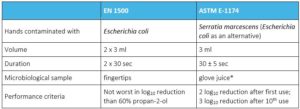Handrubs may have very different composition. There are several standards that can help us to compare the effectiveness of any products. The two most commonly used standard procedures are the EN 1500 standard (developed by CEN, the European Committee for Standardization) and the ASTM E-1174 standard (by the FDA’s Tentative Final Monograph – TFM) [1].
Both methods use experimental contamination on the hands, and counts log10 reduction in the number of colonies, but the performance criteria and the experiment parameters of the two standards are not exactly the same. It means, if a handrub formulation passes the ASTM E-1174, it may not pass the EN 1500 or vice versa [1]. Table 1 summarizes the basic experimental parameters of the two standards.
Table 1: Main experimental parameters of the two most commonly used standards for testing the efficacy of handrubs. Source: CEN EN 1500 and TFM ASTM E-1174 standard.
* Glove juice technique: Gloves were placed on subjects’ hands, then 75 ml of sampling solution was instilled into the gloves. Gloved hands were massaged for 1 minute. 3-5 ml of “glove juice” was removed and diluted for testing.
There are several other ASTM standards, closely related to the E-1174, like E-2613 for fungicide, E-2276 for bactericide, E-1838 and E-2011 for viricide effect [1]. CEN also has another standard, EN 1499 for antiseptic soaps, while the EN 1500 is for handrubs. EN 14347 is for determine sporocidal activity, EN 14348 is for mycobactericidal activity, EN 14349 is for bactericidal activity, EN 14476 is for virucidal activity, and the list is still not complete [4].
The above mentioned standards are all in vivo methods. In vitro methods would also be feasible, and even more cost effective, but results are not necessarily reflecting those of performed on human skin [1]. Lopez-Gigosos et al. 2015 described a fluorescent method that focuses on the beta-D-glucuronidase activity to determine the biocide effect against E. coli. The log10 reduction values determined with the fluorescent methods were highly correlated with the EN 1500 results in the case of the examined 5 handrubs [5].
Conclusion:
The two most commonly used standards for test the efficacy of handrubs are the EN 1500 in Europe and ASTM E-1174 in the United States and Canada. The two tests are not equivalent, if a product meets the requirements of one of the two, it does not necessarily meets with the other. Both standards have weaknesses, and this will be the topic of our next post.
